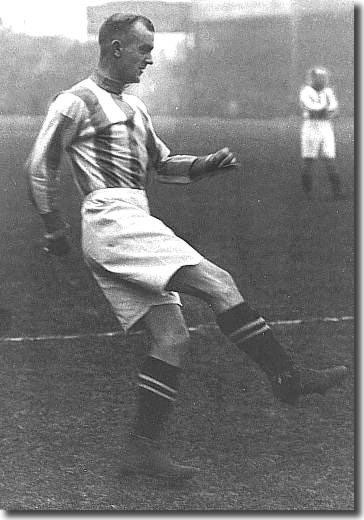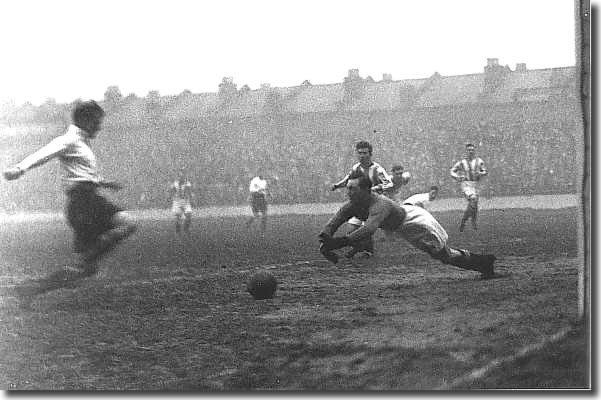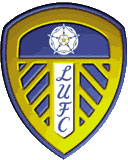 Their
first season in Division One had been a major
struggle for Leeds United, but the signings of Willis
Edwards, Tom Jennings and Russell Wainscoat at the end of the season
had proved just enough to keep them safe. In the close season manager
Arthur Fairclough made a number
of notable additions to his squad, including wingers Billy Jackson, Harry
Duggan, Jackie Fell and Bobby Turnbull plus full back Jimmy Allan.
Their
first season in Division One had been a major
struggle for Leeds United, but the signings of Willis
Edwards, Tom Jennings and Russell Wainscoat at the end of the season
had proved just enough to keep them safe. In the close season manager
Arthur Fairclough made a number
of notable additions to his squad, including wingers Billy Jackson, Harry
Duggan, Jackie Fell and Bobby Turnbull plus full back Jimmy Allan.
To finance his player recruitment, Fairclough shipped out Sam Powell,
Lawrie Baker, Albert Bell, Alan Noble, Fred Graver, Tom Bell, Bill Moore,
James Clark and Walter Coates, with George Speak retiring and Billy Down,
Jack Swan, Joe Harris and Bert Duffield leaving in the first three months
of the new season.
Clearly the high level of player turnover and financial outgoings
were an endorsement by the board of what they saw as a successful
manager, but it was a high risk approach by Fairclough which did
not pay off too handsomely. Indeed, Leeds United had to struggle
against relegation right to the very last day of the season.
They didn't start off too badly - despite an opening day defeat at Notts
County, Leeds United won five of the next 8 matches, with their forwards
in fine form, Jennings hitting 8 and Wainscoat four. Turnbull, Jackson,
Percy Whipp and Joe Harris managed five between them. They looked on the
way to a good season, but things soon turned distinctly sour.
After a 4-0 thrashing at home to Huddersfield Town, who had just won
their second successive championship and were on the way to completing
a hat-trick of titles, Leeds lost 4-2 at Everton and then 3-2 at home
to Bury. They had already conceded four in a defeat at Arsenal and the
defence was proving as leaky as in the old days. The run up to the New
Year was dismal: United won just once in the 13 games between 10 October
and a 6-3 hiding at Burnley on Boxing Day, conceding 34 goals in the process.
The departures of Down, Swan, Harris and Duffield had severely depleted
their options, though they had found £5,000 to capture Falkirk centre-half
Tom Townsley, he kept Ernie Hart on the sidelines for the next couple
of years before being successfully converted to right-back. Following
his debut on Christmas Day, Townsley missed just one league game in a
run that stretched right through to 30 March 1929, playing in 136 matches
out of 137.
United were still scoring freely, mainly due to the change in the offside
law, and John Armand was a key contributor. In the 22 games to Boxing
Day, Jennings had scored 12, Wainscoat 6, Armand 5 (in just seven matches)
and Turnbull 4. Armand followed up with another two penalties as Leeds
beat Sunderland, Notts County and Leicester in their first three league
games of 1926to give the United supporters some brief hope of a revival,
but it was short-lived. During the run, there was another first time exit
from the FA Cup, with Leeds on the wrong end of a 5-1 thrashing at the
hands of Second Division Middlesbrough.
After the Leicester victory, things started going badly wrong. Tom Jennings
scored in each of the next five games, but there was only one win. It
was a glorious one, however, 4-2 over Arsenal (who were on their way to
runners-up spot), including a Jennings hat-trick. The Yorkshire Post:
'The forwards gave an exhibition of skill ... that made their supporters
wonder why they had not won more matches this season. The result was a
personal triumph for Jennings: his tally of three goals ... indicates
that he has come back to the form which made him such a formidable centre-forward
in the early months of the season.'
They managed to put together a decent little run of three wins in the
four games to April 3, but then faltered again, losing four out of the
next five games and scoring just once. Goalkeeper Jimmy Potts had arrived
from Blyth Spartans towards the end of February and took over immediately
from Bill Johnson. He made a difference almost immediately, although United
kept losing.
On a brighter note Willis Edwards was honoured with his first cap for
England in March. Despite defeat to Wales, Edwards retained his place
for the defeat against Scotland in April.
Now, in the end of season pressure cooker at the end of April, Leeds
were staring relegation squarely in the face. They had just one match
left, on 1 May at home to Tottenham and there was a simple equation facing
them. Bottom club Notts County were already certain of finishing bottom.
Above them, Leeds and Burnley were level on 34 points, and Manchester
City, who had lost in the Cup final a week earlier, had 35. City looked
safe as they only needed a draw at Newcastle to be certain of staying
up.
If Leeds failed to beat Tottenham, they would be pitched back down to
the Second Division.
Burnley soon established a winning lead against Cardiff City, taking
a three-goal advantage by the interval. Leeds had a stiffer fight against
Spurs. The match was played on very heavy ground, and though the London
club played the cleverer football the conditions were all against them,
though the sides remained level at the break. The United players came
out like a tornade in the second half and ran out 4-1 victors, with Jennings scoring twice.
second half and ran out 4-1 victors, with Jennings scoring twice.
back to top
Manchester City showed their old disastrous weakness in defence, conceding
three goals to Hughie Gallacher, Newcastle's Scottish centre-forward.
City missed a golden chance of securing safety when Austin fluffed a penalty
after Roberts had pulled one goal back. Browell scored a fine goal to
bring the score back to 3-2, but it was not enough and United were safe,
a point clear of City and level with Burnley, finishing above them by
virtue of a superior goal average. It was a narrow squeak.
Jennings'goals made all the difference - he top scored with 26, and was
the only ever-present. It was United's best individual goal haul so far
but there was no-one else in double figures.
Other Football Highlights from 1925/26
- The alteration in the offside law shook things up and the expected
goal glut duly arrived. The total number of goals scored in the Football
League rose from 4,700 to 6,373. On the opening day of the season Aston
Villa scored 10 against Burnley; then Newcastle beat Arsenal 7-0; Arsenal
retaliated by putting five past Cardiff; Tottenham and Huddersfield
drew 5-5
- New Arsenal manager Herbert Chapman
bought 33-year-old Charlie Buchan from Sunderland. The financial arrangements
were handled by the Arsenal chairman Sir Henry Norris, who refused to
pay the £4,000 Sunderland wanted. When Bob Kyle, the Sunderland
manager, justified the fee by claiming that Buchan would score 20 goals
in his first season, Norris challenged him to put his money where his
mouth was and the deal struck was £2,000 down with another £100
per goal. Buchan eventually hit 21 and won an argument with Chapman
about a formation to cope with the changed offside law. The old 2-3-5
formation was now moving to 3-3-4 as the centre-half dropped into defenceand
and an inside-forward was withdrawn
- League champions again, Huddersfield became the first club to win
the title three seasons running. They finished five points clear of
Arsenal
- Manchester City, relegated from Division One to end a 17-year stay,
also lost in the Cup final. On the way to Wembley, they beat champions
Huddersfield 4-0, Crystal Palace 11-4 and neighbours United 3-0 in the
semis. A goal from Bolton's David Jack saw Wanderers win the Cup 1-0.
Jack had also scored the winner in the 1923 final
- Bobby Skinner of Dunfermline set a British record with 53 goals in
the Scottish Second Division












 Their
first season in Division One had been a major
struggle for Leeds United, but the signings of Willis
Edwards, Tom Jennings and Russell Wainscoat at the end of the season
had proved just enough to keep them safe. In the close season manager
Arthur Fairclough made a number
of notable additions to his squad, including wingers Billy Jackson, Harry
Duggan, Jackie Fell and Bobby Turnbull plus full back Jimmy Allan.
Their
first season in Division One had been a major
struggle for Leeds United, but the signings of Willis
Edwards, Tom Jennings and Russell Wainscoat at the end of the season
had proved just enough to keep them safe. In the close season manager
Arthur Fairclough made a number
of notable additions to his squad, including wingers Billy Jackson, Harry
Duggan, Jackie Fell and Bobby Turnbull plus full back Jimmy Allan. second half and ran out 4-1 victors, with Jennings scoring twice.
second half and ran out 4-1 victors, with Jennings scoring twice.